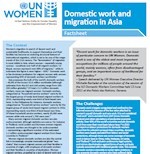
Factsheet Domestic work and migration in Asia

Women’s migration in search of decent work and sustainable livelihoods, to support themselves and their families has become an enduring structural feature of international migration, which is set to be one of the mega-trends of the 21st century. The “feminization” of migration is most visible in Asia, where women – especially young women - constitute over half of all migrant workers. In Nepal, women represent over 68% of migrants, while in Indonesia this figure is even higher – 83%. Domestic work is the dominant profession for migrant women with women representing 83% of domestic workers worldwide.
Asia possesses the bulk of the world’s domestic workers – 40.8% of the known 52.6 million worldwide (although estimates from the ILO and civil society range from 100-200 million globally). Of Asia’s 21.5 million domestic workers, many are migrant women. Domestic workers, categorized as “household service workers” were by far the largest group of newly land-based migrant workers in 2010, representing nearly one-third of land-based new hires. In the Philippines for instance, domestic workers, categorized as “household service workers” were by far the largest group of newly land-based migrant workers in 2010, representing nearly one-third of land-based new hires. Of these household service workers, nearly 95,000 were women while only around 1,700 were men.
Many women migrant domestic workers are also undocumented, although statistics are scarce. For instance in Thailand, most Laotian and Burmese women migrant domestic workers are thought to be undocumented – representing a significant number of the estimated 1-2 million undocumented migrant workers from these countries in Thailand.
Women migrant domestic workers are also the central link in increasingly complex transnational global “care chains” that connect migrant women and their families in countries of origin, with employers of domestic workers and their families in countries of destination. Women migrant workers, propelled by a lack of decent work and sustainable livelihoods, and other inequalities including gender discrimination, respond to the demand for domestic work created in countries of destination. This demand is fuelled by: aging populations, especially in middle income and developed nations; women’s increased participation in the workforce; unequal divisions of care and domestic work responsibility in the home; the desire of some women to maintain a certain lifestyle and social status; and the reluctance of nationals to undertake low-paid, low-status work that is considered “women’s work. These factors collude to create a “care crisis” - and hiring women migrant domestic workers is seen as an affordable, convenient solution to the problem. Women migrant domestic workers are thus seen as readily available, needy, inexpensive, pliable, and naturally imbued with nurturing and home-care abilities.
Their own families are left behind in countries of origin and must find new strategies and solutions to meet their own increased domestic and care needs.